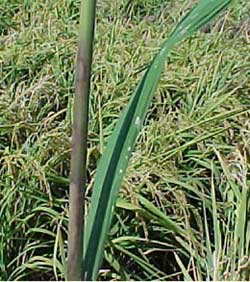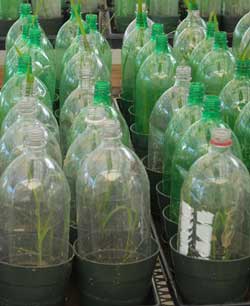Fayetteville, Arkansas
February 19, 2008
 |
|
Branching pattern
of mycelia that is unique to the rice sheath
blight fungus |
|
 |
|
Disease symptoms
on a plant in the field |
|
 |
Soft-drink bottles
that can each provide a different micro-climate
for rapid screening of plants for reactions to
sheath blight.
Photos by molecular pathologist Yulin Jia |
|
Plant breeders who develop
improved rice varieties are getting new tools to speed up the
process of combining genes for higher yield, disease resistance,
better quality and other desirable traits in new commercial
varieties.
The University of Arkansas
System's Division of Agriculture is the leader of a multi-state
research program called RiceCAP, or Rice Coordinated
Agricultural Project, funded by a $5 million grant from the U.S.
Department of Agriculture. The project began in 2005 and
concludes in October 2008. RiceCAP coordinator is Jim Correll, a
Division of Agriculture professor of plant pathology based on
the university campus at Fayetteville.
The Division of Agriculture
operates one of the world's leading rice breeding programs at
its Rice Research and Extension Center near Stuttgart.
New tools for rice breeders include genetic markers, which
reveal the presence of genes linked to a particular genetic
trait, Correll says. These markers are not "the answer" to
problems that breeders are addressing, he says, but they help
them make more precise selections in their crossbreeding efforts
to achieve elusive combinations of genetic traits.
"Markers are currently used by our breeders. They are genomic
tools, but that doesn't mean we will be developing genetically
engineered rice varieties," Correll says. That point is very
important, because many export customers for Arkansas rice will
not accept genetically engineered rice, he says.
Plant breeding is a lengthy process. When a breeder identifies a
plant with targeted traits that represent an improvement over
the varieties available to growers, the breeder selects that
plant as a parent in a crossbreeding program. The basic process
has been used since the 19th century, but advances have been
made in areas such as screening plant populations for desirable
crossbreeding parents.
In the first few generations of crossbreeding, some offspring
usually have a superior combination of traits and others don't.
The crossbreeding goes on for several generations until a
population of plants is obtained with a consistent combination
of traits. Only at that point can the seed from a new "breeding
line" be trusted to produce a consistent yield and quality of
grain. The process can take seven to 10 years from the time a
"parent" plant is selected for use in a breeding program.
Speeding up the process of bringing improved varieties to
farmers is a major goal, Correll says.
A marker is an easily identifiable piece of genetic material,
usually DNA, that scientists have determined is linked to a
particular trait, Correll says. Thus, markers allow breeders to
be more selective in crossbreeding and might save months or
years in the development of an improved variety.
Correll says RiceCAP is developing new markers for genes
associated with the fungal disease sheath blight in rice plants.
Ultimately more important that providing new markers, he says,
is the understanding scientists are gaining about the genetics
of rice in general and sheath blight in particular.
Another RiceCAP focus is milling yield, which is a measure of
the portion of whole grains milled from a lot of rough rice.
Both sheath blight resistance and milling yield are difficult
objectives because they are controlled by multiple genes and are
greatly affected by environmental factors, Correll says.
An example of a new marker for sheath blight susceptibility is
found in a project by Steven Brooks, a Division of Agriculture
adjunct scientist and molecular pathologist at the USDA's Dale
Bumpers National Rice Research Center near Stuttgart.
Brooks isolated a toxin produced by the sheath blight fungus and
determined that plants that are sensitive to the toxin tend to
be susceptible to sheath blight disease damage.
"This work provides the means to genetically map toxin
sensitivity genes and eliminate susceptible genotypes when
developing sheath blight-resistant cultivars," Brooks says in a
paper published in the journal Phytopathology.
Yulin Jia, another molecular pathologist at the USDA Rice
Research Center and a Division of Agriculture adjunct scientist,
developed a "micro-chamber" screening method. It is faster and
cheaper than field tests to determine if plants are susceptible
or resistant to sheath blight. It is described in an article in
the journal Plant Disease.
RiceCAP also has educational and outreach components. It
involves graduate students in genomics research to help train
the next generation of plant breeders in emerging technologies,
Correll says. Scientists also have conducted workshops to help
high school and junior high teachers incorporate genetics
research into science courses. |
|